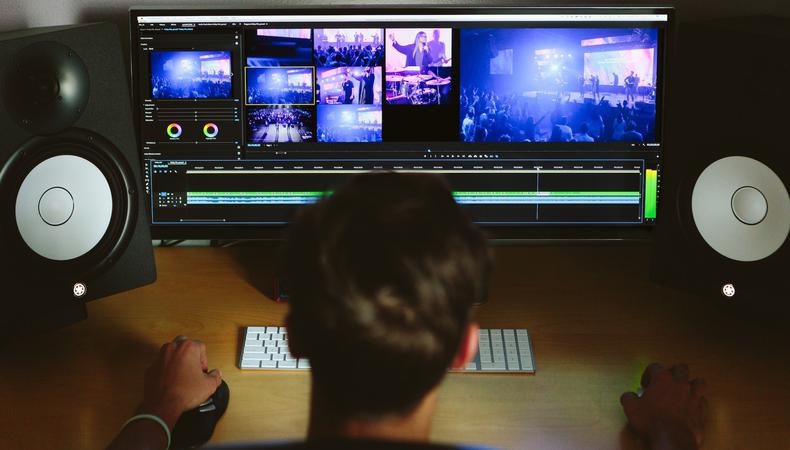Film editing is a crucial part of the filmmaking process. It involves selecting, arranging, and modifying footage to create a coherent and engaging story. Without effective editing, even the most well-shot scenes can fall flat. Editors work closely with directors to ensure that the final product aligns with their vision, maintaining the pacing, tone, and emotional impact of the film.

Good editing can transform a mediocre film into a great one. It allows for the seamless transition between scenes, helps to build tension, and enhances the overall narrative flow. Editors use various techniques, such as cutting on action, cross-cutting, and montage, to create a visually compelling and emotionally resonant story. The editor’s role is not just technical; it is also highly creative, requiring a deep understanding of storytelling and visual language.
In the digital age, film editing has become more accessible, with software like Adobe Premiere Pro and Final Cut Pro enabling editors to work more efficiently. Despite the technological advancements, the fundamental principles of film editing remain unchanged. The editor’s primary goal is to serve the story and enhance the viewer’s experience.
The Evolution of Film Editing Techniques
Film editing has come a long way since the early days of cinema. In the silent film era, editors used physical cutting and splicing of film reels. This labor-intensive process required precision and skill. With the advent of sound in films, editing became even more complex, as editors had to synchronize audio and visual elements seamlessly.
The introduction of digital technology revolutionized film editing. Non-linear editing systems (NLEs) like Avid Media Composer and later software such as Adobe Premiere Pro and Final Cut Pro transformed the industry. These tools allowed editors to experiment more freely with footage, making the editing process faster and more efficient.
Modern editing techniques include the use of computer-generated imagery (CGI) and visual effects (VFX) to create scenes that were previously impossible. Additionally, color grading has become a significant aspect of editing, enhancing the visual tone and mood of a film. As technology continues to advance, the possibilities for film editing are expanding, allowing for even greater creativity and innovation in storytelling.
The Role of the Editor in Filmmaking
The editor plays a vital role in shaping the final product of a film. They work closely with the director to understand the vision and tone of the movie. From the initial assembly cut to the final version, editors meticulously craft the narrative, ensuring that each scene serves the story effectively.
Editors are responsible for maintaining continuity, ensuring that the film flows smoothly from one scene to the next. They also work on pacing, determining the rhythm of the film by deciding how long each shot should last. This can dramatically affect the audience’s emotional response and engagement with the story.
In addition to technical skills, editors need a keen sense of timing and storytelling. They often make crucial decisions that impact the film’s overall narrative arc and emotional impact. Through their work, editors have the power to enhance performances, emphasize key moments, and create a cohesive and compelling story that resonates with audiences.
Key Techniques Used in Film Editing
Several key techniques are fundamental to the art of film editing. One of the most basic is the cut, which transitions from one shot to another. There are various types of cuts, including jump cuts, match cuts, and cross-cuts, each serving a different narrative purpose.
Jump cuts can create a sense of urgency or disorientation, while match cuts provide a visual or thematic connection between scenes. Cross-cutting, or parallel editing, allows editors to show two or more simultaneous actions, building tension or highlighting contrasts.
Other techniques include the use of transitions such as dissolves, fades, and wipes to signify changes in time or place. Editors also employ montages to condense time or convey a series of events quickly. Additionally, sound editing and the integration of music play crucial roles in setting the mood and enhancing the storytelling.
These techniques, when used effectively, can elevate the narrative and emotional impact of a film, making the editing process a vital aspect of filmmaking.
Challenges Faced by Film Editors
Film editing is not without its challenges. One of the primary difficulties is dealing with a vast amount of footage. Editors often have to sift through hours of raw material to find the best takes and angles. This requires patience, attention to detail, and a keen eye for what works best for the story.
Another challenge is maintaining continuity. Ensuring that all elements are consistent from scene to scene, such as lighting, props, and actor positions, can be incredibly demanding. Editors must be meticulous in spotting and correcting any inconsistencies to maintain the film’s realism and immersion.
Time constraints are also a significant challenge. Editors often work under tight deadlines, requiring them to balance speed with precision. Collaborating effectively with directors, producers, and other team members is crucial to ensure that the final product meets everyone’s expectations while staying on schedule.
The Impact of Digital Technology on Film Editing
Digital technology has had a profound impact on film editing. The transition from physical film to digital formats has made the editing process more efficient and flexible. Non-linear editing systems (NLEs) allow editors to access any part of the footage instantly, making it easier to experiment and make changes.
Digital technology has also enhanced the quality of visual effects and CGI, allowing for more sophisticated and seamless integration of these elements into films. Additionally, tools for color correction and grading have become more advanced, enabling editors to fine-tune the visual style of a film to a greater degree.
Despite these advancements, the core principles of film editing remain the same. The goal is still to tell a compelling story and create an emotional connection with the audience. Digital tools have simply expanded the possibilities for how editors can achieve these goals, offering new ways to enhance and innovate in the art of film editing.
The Future of Film Editing
The future of film editing is likely to be shaped by continued technological advancements. Artificial intelligence (AI) and machine learning are beginning to play a role in editing, with tools that can automate certain tasks, such as sorting footage or suggesting edits based on patterns and preferences.
Virtual reality (VR) and augmented reality (AR) are also emerging as new frontiers for film editing. These technologies offer immersive storytelling possibilities, requiring editors to develop new skills and techniques to craft experiences that engage viewers in entirely new ways.
As the industry evolves, the role of the editor will continue to be central to the filmmaking process. While technology may change how editors work, the fundamental principles of storytelling, creativity, and collaboration will remain at the heart of the art of film editing.
The Psychological Impact of Film Editing
Film editing not only shapes the narrative structure of a film but also has a profound psychological impact on the audience. Through editing, filmmakers can manipulate time, space, and perspective to evoke specific emotions and reactions from viewers.
One way editors achieve this is through the use of pacing. By controlling the rhythm of cuts, editors can build tension, create suspense, or provide relief. Fast cuts can create a sense of urgency and excitement, while longer takes can establish a more relaxed or contemplative mood.
Editors also use juxtaposition to influence the audience’s perception. The Kuleshov Effect, a film editing phenomenon discovered by Soviet filmmaker Lev Kuleshov, demonstrates how viewers derive meaning from the sequencing of shots. For example, a neutral facial expression followed by an image of food can be interpreted as hunger, while the same expression followed by a coffin can be seen as grief.
Transitions between scenes, such as dissolves, wipes, and fades, can signal changes in time, location, or emotional tone. These transitions help guide the audience through the narrative, providing visual cues that enhance understanding and engagement.
Ultimately, effective film editing taps into the psychology of the audience, using visual and auditory techniques to shape their emotional and cognitive experience of the film.
The Role of Sound and Music in Film Editing
Sound and music are integral components of film editing, significantly enhancing the storytelling process. Sound editors work closely with film editors to ensure that audio elements such as dialogue, sound effects, and ambient sounds are seamlessly integrated with the visual footage.
Dialogue editing involves cleaning up and synchronizing recorded dialogue, often requiring adjustments to match lip movements perfectly. Sound effects add depth and realism to the film, from the subtle rustling of leaves to the dramatic explosions in an action sequence.
Music plays a vital role in setting the tone and mood of a film. Editors use musical scores to underscore emotional moments, build tension, and create a rhythm that complements the visual pacing. The placement of music cues is carefully considered to enhance the narrative impact without overpowering the scene.
Sound bridges, where audio from one scene continues into the next, can create smooth transitions and maintain continuity. These techniques help to immerse the audience in the film’s world, making the viewing experience more engaging and emotionally resonant.
In summary, sound and music are powerful tools in the hands of skilled editors, used to elevate the storytelling and create a more immersive and impactful film.
- Starburst Wilds Explained: How This Feature Keeps Players Hooked - January 29, 2025
- The Role of CBD Oil in Managing Symptoms of Candida Infections - October 3, 2024
- Cultural Influences on Slot Game Design in Thailand - August 21, 2024
